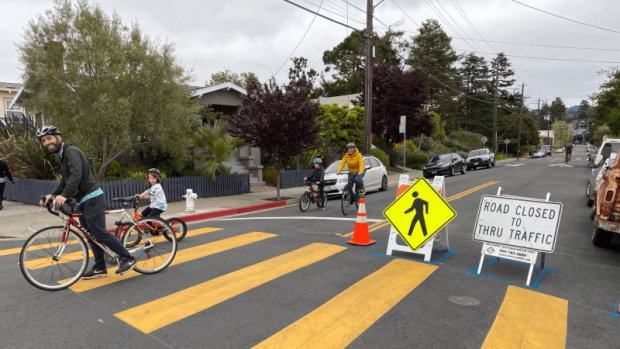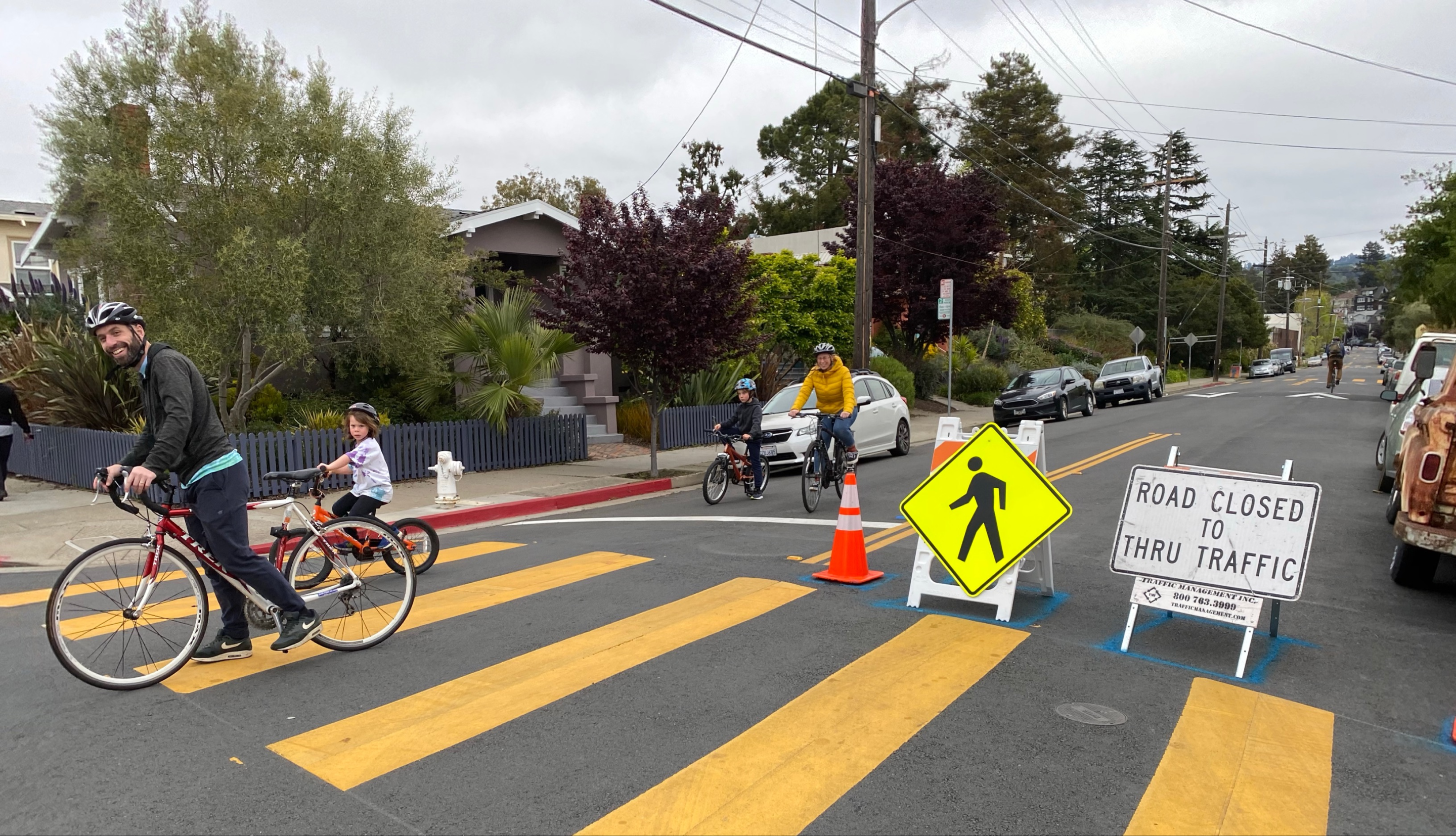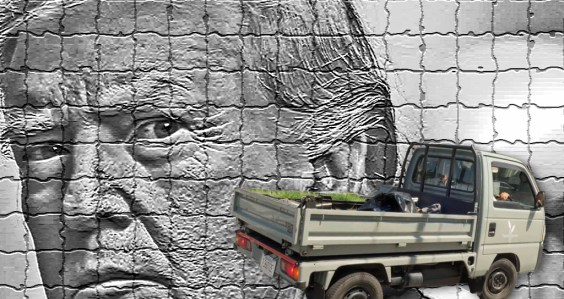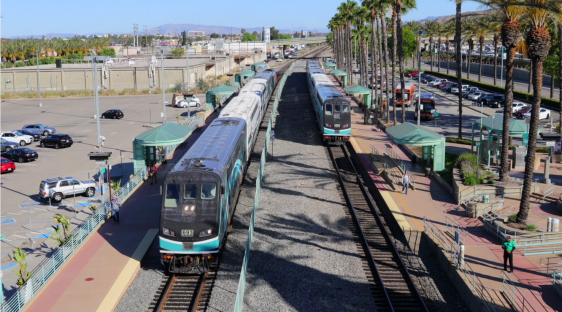
Updated | Mayor de Blasio just did the City Council 33 percent better — he’s committed to opening up 100 miles of streets for socially responsible recreation during the COVID-19 crisis.
At his virtual press conference, de Blasio said negotiations with the City Council — which is pushing its own bill for 75 miles of car-free space — have yielded success: 40 miles of open streets this month, with a goal of 100 miles at an unspecified date in the future of the crisis.
“The City Council came forward with a vision for how we could open up more streets and do it in a way that’s responsive to the core concerns of the NYPD over safety and enforcement,” the mayor said. “Over the next month, we will create a minimum of 40 miles of open streets. And as the crisis continues, the goal is to get up to 100 miles. We will focus first on streets in and around our parks.”
The mayor also said the city would look to “expand sidewalks” and create more temporary bike lanes.
“We want to do more,” he said. “So the focus here will be to focus on where the need is greatest. … The first priority is the places hardest hit and then where it will have the most impact.”
Activists were immediately excited — and knew how to apportion the credit:
“It’s great to see the Council break through on the issue,” said Jon Orcutt of Bike New York, and a former top DOT official. “We’re very heartened the announcement included some looking-ahead steps, like more pop-up bike lanes.”
The mayor’s statement still emphasized “enforcement,” which led to the demise of the NYPD’s initial, 11-day open space program last month, which included the deployment of many police officers and other employees at each intersection along four short stretches of roadway.
The mayor’s latest announcement comes after the City Council expressed its frustration with his inability to create more open space during the crisis, frustration that took the form of legislation last week mandating the transformation of 75 miles of roadways into open space — a proposal that followed the example of other cities, none of which required a large police presence.
But on Monday, Council Speaker Johnson praised the mayor.
“The Council is thrilled our calls for open streets have been answered and looks forward to working with the administration to give New Yorkers the space they need to socially distance properly,” the speaker said in a statement. “As the weather gets nicer and this unprecedented crisis stretches on longer, we need to do everything in our power to keep our neighbors safe and healthy. This announcement is a great starting point for the ongoing conversation about how we share our public spaces during this pandemic and in a post-coronavirus future.”
The mayor’s initiative also comes one day after the New York Times editorial board, following many other outlets, called on the city to create far more open space, especially as the summer looms. And it follows the mayor’s decision to force his DOT commissioner, Polly Trottenberg, to defend the NYPD’s open-space enforcement strategy at the City Council’s hearing on Friday (a performance that led to the latest Streetsblog song parody, “Dear Polly”).
And it comes after Johnson threatened to seek the support of Gov. Cuomo to pressure the mayor to show “leadership on the issue.”
If the Mayor won’t open streets to New Yorkers, who so desperately need safe public spaces right now, the @NYCCouncil will look to @NYGovCuomo for leadership on this issue. We are prepared to work with the State to make this happen. https://t.co/PhDIXfbeG6
— NYC Council Speaker Corey Johnson (@NYCSpeakerCoJo) April 26, 2020
On Monday, Cuomo confirmed that he was about to step in, telling reporters at his briefing that he would have gotten involved if Johnson and de Blasio didn’t make a deal.
A Council source told Streetsblog that de Blasio threw in the towel after watching his commissioners get roasted at Friday’s hearing — only to have the New York Times later editorialize in favor of open streets.
The mayor’s announcement also came a day after he was angrily confronted in Prospect Park for continuing his practice of being driven 11 miles from his mansion inside a park to get to another park so he can get exercise. Area resident Darren Goldner posted the incident on Twitter, perhaps playing a role in opening up the mayor’s eyes to how the public viewed his earlier refusal to create open space during the crisis:
I live right near Prospect Park. It's a nice place to exercise at distance. Today, I ran into @nycmayor @billdeblasio w/ @nycfirstlady there.
But they live 11 miles away *inside* another park and force a 4 SUV entourage to drive them non-essentially to Bklyn for recreation (1/n) pic.twitter.com/4BLjSotw2n
— darren (@DarrenGoldner) April 25, 2020
The mayor promised more details this week, and said the first 40 miles would start being created in May. It’s unclear whether the city will reach its 100-mile goal, which the mayor said was dependent on the length of the crisis. Streetsblog was given a follow-up question, which the mayor answered in a manner that suggests he has seen the light about open streets.
Streetsblog: You are still emphasizing enforcement, which led to the demise of the NYPD’s original open-space pilot. So what’s the difference now? Have you accepted the Council’s position that open streets can be done with far fewer cops and with more trust in drivers to stay out of areas where they don’t belong?
Mayor de Blasio: I had a long conversation with [NYPD] Commissioner [Dermot] Shea and Commissioner Trottenberg and we went deeply into the plans from other cities — Oakland, Minneapolis, etc. — and our comparison to New York City and what it would take here. I think there is an assumption in everything we do that gets back to Vision Zero that we want to be very cautious about making sure drivers are constantly given the message, “Slow down. Drive safely. Recognize the ramifications of what it means to drive a vehicle.” So that worldview makes us very cautious about trusting that if you create a situation where there are not protections and not enforcement that you could put people in danger. And the goal of an open-street structure is that people can enjoy it without having a new danger from vehicles. … The discussions with the Council were kindred in the sense that we could come up with places to open — and the areas around parks are a great example — whereby opening them up, you capture the natural flow of people…where people are going anyway. That is a more straightforward enforcement dynamic than if you are trying to open a bunch of places all over. The focus is on where the need is greatest — where people are going and obviously communities that are most affected — using some of the enforcement strategies we are already devoting to those areas. And then more and more the conversation focused on something the Council felt deeply, and we felt was an important piece, revolved around community partners that could be relied upon to create structures that if you were going to have a place closed off, there would be a constant effort to monitor it to make sure it’s safe and to get NYPD over there if it isn’t. More structure, for example, of what we saw in Oakland. … We’re not forgetting what we learned with Vision Zero, which is to always keep our guard up against the problems of people who drive irresponsibly.
Residents of several areas of the city immediately called for open streets in their neighborhood.
“We are thrilled the mayor succumbed to pressure,” said Jim Burke, who heads the Queens volunteer committee for Transportation Alternatives. “He was probably panicked that Cuomo would overrule him. We want 34th Avenue done first because Jackson Heights and Corona are the epicenter of this pandemic the suffering — and we have high percentage of essential workers. Sidewalks are narrow. We basically have one park in whole neighborhood and it’s crowded now, even before summer. We have no protected bike lanes at all. We need safe ways to travel in place now. We need space.”





